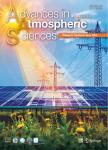Hydro-climatic Characteristics of Yarlung Zangbo River Basin since the Last Glacial Maximum
Hydro-climatic Characteristics of Yarlung Zangbo River Basin since the Last Glacial Maximum作者机构:Institute of Mountain Hazards and EnvironmentChinese Academy of SciencesChengdu 610041China Geography&EnvironmentUniversity of SouthamptonHighfieldSouthamptonSO171BJUK
出 版 物:《Advances in Atmospheric Sciences》 (大气科学进展(英文版))
年 卷 期:2022年第39卷第3期
页 面:415-426页
核心收录:
学科分类:08[工学] 081501[工学-水文学及水资源] 0815[工学-水利工程] 0706[理学-大气科学]
基 金:supported by the National Natural Science Foundation of China(Grant No.91747207) the project of CAS“Light of the West”。
主 题:Yarlung Zangbo River Basin Indian summer monsoon glacier change runoff variability since the LGM
摘 要:Global climate changes significantly impact the water condition of big rivers in glacierized high mountains. However,there is a lack of studies on hydrological changes within river basins caused by climate changes over a geological timescale due to the impossibility of direct observations. In this study, we examine the hydro-climatic variation of the Yarlung Zangbo River Basin in the Tibet Plateau since the Last Glacial Maximum(LGM) by combining δ18 O proxy records in Indian and Omani caves with the simulated Indian summer monsoon, surface temperature, precipitation, evapotranspiration and runoff via the Community Climate System Model and the reconstructed glacier coverage via the Parallel Ice Sheet Model. The mean river runoff was kept at a low level of 145 billion cubic meters per year until an abrupt increase at a rate of 8.7 million cubic meters per year in the B?lling-Aller?d interval(BA). The annual runoff reached a maximum of 250 billion cubic meters in the early Holocene and then reduced to the current value of 180 billion cubic meters at a rate of 6.4 million cubic meters per year. The low runoff in the LGM and Heinrich Stadial 1(HS1) is likely attributed to such a small contribution of precipitation to runoff and the large glacier cover. The percentage of precipitation to runoff was only 20%during the LGM and HS1. Comparison of glacier area among different periods indicates that the fastest deglaciation occurred during the late HS1, when nearly 60% of glacier area disappeared in the middle reach, 50% in the upper reach,and 30% in the lower reach. The rapid deglaciation and increasing runoff between the late HS1 and BA may have accelerated widespread ice-dam breaches and led to extreme outburst flood events. Combining local geological proxy records and regional simulations could be a useful approach for the study of paleo-hydrologic variations in big river basins.



